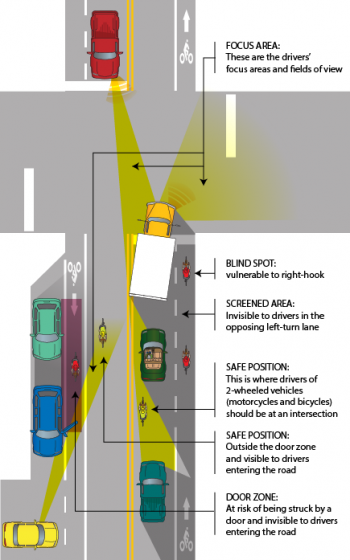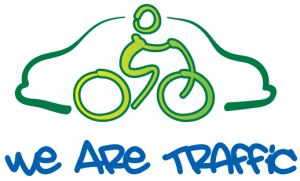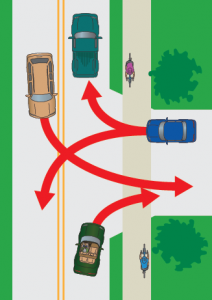Info for Bicyclists
Ten Tips for Successful Cycling
Courtesy of CyclingSavvy
1) Ride on the road.
Adult bicyclists do not belong on the sidewalk. Sidewalk cycling increases conflict for cyclists, motorists and pedestrians. Sidewalk cycling is not only inconvenient and slow, it actually increases your risk of being hit by a car because it aggravates turning and crossing conflicts. The sidewalk also presents many more hazards such as poles, posts and branches.
2) Know and follow the rules.
The rules of the road are for everyone. They exist to make us all predictable to one another. Bicyclists who violate the rules are not only far more likely to be hit by a car, they are disruptive and breed animosity among fellow road users. The basic rules:
- First come, first served.
- Always ride the same direction as traffic.
- Yield to traffic before entering a road.
- Yield to overtaking traffic when changing lanes.
- Obey all traffic control devices.
3) Integrate in the intersections.
- Always use the lane that serves your destination.
- Turn left from left turn lanes.
- Never ride straight in a right-turn-only lane.
- When approaching an intersection in a wide lane or a bike lane, merge left into the main traffic flow or lane.
- The crosswalk is the WORST place to cross a busy intersection.
4) Ride Big.
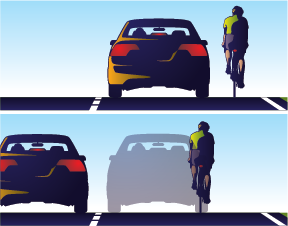
Most close passing is a result of the motorist thinking he can squeeze past without changing lanes. Make sure a driver can clearly see that his car won’t fit within the same lane.
Most roads have lanes that are not wide enough to be safely shared by cars and bikes operated side-by-side. You are allowed the full use of a lane that is not wide enough to share. Communicate that the lane is not wide enough for a motorist to squeeze past you by riding far enough left that there clearly is not room for the width of a car between you and the lane line.
Riding big makes you visible and encourages motorists to give generous passing clearance. It also gives you someplace to go if a motorist does come too close.
5) Communicate.
You are part of the system, you need to be predictable to others. Communication makes you predictable. Signal turns and lane changes. When motorists know what you want to do, most of them will try to help you out!
6) Be mindful of your surroundings.
Markings on the roadway are static. Traffic is dynamic. As a result, bike-specific markings sometimes put you in the wrong place. You MUST take your cues from the whole environment. Never let paint think for you.
- Make sure you are visible to crossing and turning traffic. This often means leaving a bike lane and moving to the left side of the general use lane.
- Never ride within 5ft of a parked car. This area is called the “door zone.” A suddenly-opened car door can be deadly. Some bike lanes are striped entirely within the door zone.
- Passing a queue of stopped traffic on the right can expose you to many crash hazards. Sometimes it’s better just to wait in the queue.
- Never, ever pass a large truck on the right!
7) Understand how traffic flows.
If you understand traffic flow, you can anticipate and place yourself in a position which makes things easier for yourself and your fellow road users. In the CyclingSavvy course, we teach you in detail about how traffic controls and road features influence traffic flow, and how you can take advantage of this.
8) Want respect? Act respectably.
Be considerate of your fellow road users. But also demonstrate respect for yourself. Control your space by default and help motorists pass you when appropriate. Offer a friendly wave when others are respectful of you. When motorists arrive before you at a red light, stop behind them. Don’t pull to the front of the queue and make them have to get around you after the intersection.
9) Let it go: don’t escalate harassment.
You will be passed uneventfully by thousands of considerate citizens for every one jerk who yells or honks. So, when someone does honk or yell at you, let it go. Smile and wave (with all five fingers), or pretend you heard nothing. They will simply move on with their negative self and you can remember the nice person who smiled and waved you through a lane change a few minutes before.
10) Keep it fun!
Bicycling offers a higher trip quality than most other forms of transportation. This is true whether you ride on quiet streets or share the road with motor traffic. Interacting with other road users is a dance you lead. The better you are at communicating and operating predictably, the better your dance partners will be. Those of us who ride mindfully, with a friendly attitude toward our fellow road users, seldom experience close calls or hostility.
Common Collisions Caused by Motorist Error
(But Avoidable by Savvy Cycling):
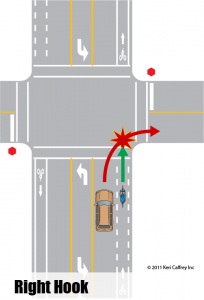 Overtaking Right-hook: motorist passes and turns right in front of cyclist. This can happen to a cyclist riding on the edge of a narrow or wide lane, or in a bike lane. The easier it is for a motorist to pass prior to the intersection, the more risk there is for this crash. Motorists do this because they underestimate the speed of the cyclist, and they have to slow before turning (decreasing the speed differential and the distance needed to clear the cyclist).
Overtaking Right-hook: motorist passes and turns right in front of cyclist. This can happen to a cyclist riding on the edge of a narrow or wide lane, or in a bike lane. The easier it is for a motorist to pass prior to the intersection, the more risk there is for this crash. Motorists do this because they underestimate the speed of the cyclist, and they have to slow before turning (decreasing the speed differential and the distance needed to clear the cyclist).
Savvy Cycling: Make it easier for motorists to do the right thing. Keep ‘em behind you. Ride father left. If a motorist has to change lanes to pass before turning, that’s often enough stimulus to make him think about the time/distance/effort and choose to wait until you clear the intersection. Move to the left side of the lane before an intersection with a high volume of right-turning traffic, or before a lane splits into a straight-thru and right-turn lane. If you’re in a bike lane, leave the bike lane prior to the intersection to discourage motorists from passing.
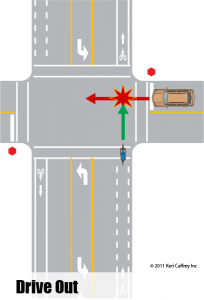 Drive-out: motorist pulls out from side street into cyclist’s path. This is often exacerbated by sight obstructions (hedges, polls, utility boxes) on the side of the road.
Drive-out: motorist pulls out from side street into cyclist’s path. This is often exacerbated by sight obstructions (hedges, polls, utility boxes) on the side of the road.
Savvy Cycling: Ride farther left, they are more likely to see you if you are in the traffic lane where they are looking. Stay out of shoulders and undesignated areas to the right of the edge-line, especially where there are a lot of driveways and cross-streets. Even avoid marked bike lanes if they reduce your visibility to crossing traffic. Scan for sight obstructions and move left for better vantage. If you can’t see traffic approaching a side street, those drivers can’t see you.
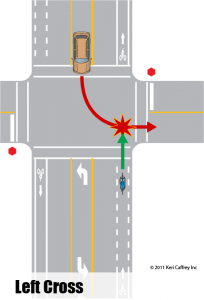 Left-cross: motorist turns left into, or front of, the cyclist. This happens because the cyclist is irrelevant to the motorist or the motorist underestimates the cyclist’s speed.
Left-cross: motorist turns left into, or front of, the cyclist. This happens because the cyclist is irrelevant to the motorist or the motorist underestimates the cyclist’s speed.
Savvy Cycling: Ride farther left, they are focused on the oncoming traffic lane and a leftward position indicates higher speed. Keep pedaling; if you coast, they think you are yielding to them. Be prepared to execute an emergency maneuver – which you can learn in CyclingSavvy. CommuteOrlando offers a comprehensive animation on preventing the left cross.
 Screened Left-cross: motorist turns left into, or front of, cyclist because the cyclist has been screened by another overtaking vehicle. This can happen on a multilane road or any time the cyclist is operating alongside a line of traffic (wide lane or bike lane).
Screened Left-cross: motorist turns left into, or front of, cyclist because the cyclist has been screened by another overtaking vehicle. This can happen on a multilane road or any time the cyclist is operating alongside a line of traffic (wide lane or bike lane).
Savvy Cycling: Learn to recognize the conditions that create a moving screen. Know where the potential conflicts are and make sure you establish a vantage from which to see them (move left into the lane). Do not blindly enter an intersection if you have not been able to see the oncoming lanes.
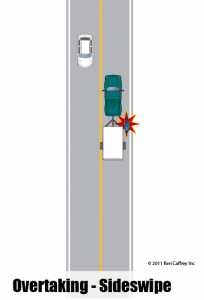 Side-swipe: Motorist tries to squeeze between cyclist and centerline, median or oncoming traffic. Especially problematic are landscape trailers and box trucks, whose drivers don’t account for the width of their vehicles. This crash typically happens in narrow lanes when the cyclist is riding at the edge. It can happen in bike lanes when large vehicles off-track or drift — especially around curves.
Side-swipe: Motorist tries to squeeze between cyclist and centerline, median or oncoming traffic. Especially problematic are landscape trailers and box trucks, whose drivers don’t account for the width of their vehicles. This crash typically happens in narrow lanes when the cyclist is riding at the edge. It can happen in bike lanes when large vehicles off-track or drift — especially around curves.
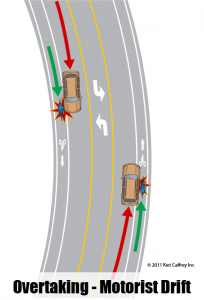 Savvy Cycling: Ride farther left to discourage same-lane passing in narrow lanes. A cyclist needs ~7 feet for operating space and passing clearance. Look at the lane in front of you: if it is the width of 2 SUVs, it is wide enough to share; if not, move left and claim the lane. Remember, you are not choosing a lane position to accommodate small cars. You must ride in a consistent, predictable position while maintaining your focus forward. You cannot afford to focus your attention monitoring what kind of vehicles are behind you and adjusting your lane position. Don’t be afraid to leave a bike lane if you do not feel safe in it. If motorists have to slow behind you before passing, they are more likely to pass you safely… even if you then choose to move into the bike lane to make it easier for them.
Savvy Cycling: Ride farther left to discourage same-lane passing in narrow lanes. A cyclist needs ~7 feet for operating space and passing clearance. Look at the lane in front of you: if it is the width of 2 SUVs, it is wide enough to share; if not, move left and claim the lane. Remember, you are not choosing a lane position to accommodate small cars. You must ride in a consistent, predictable position while maintaining your focus forward. You cannot afford to focus your attention monitoring what kind of vehicles are behind you and adjusting your lane position. Don’t be afraid to leave a bike lane if you do not feel safe in it. If motorists have to slow behind you before passing, they are more likely to pass you safely… even if you then choose to move into the bike lane to make it easier for them.
Uncommon Collisions Caused by Gross Negligence:
Rear-end: Motorist runs smack into the back of a cyclist. This is a rare type of collision and usually involves darkness, lack of proper bike lights, alcohol or some form of distraction on the part of the motorist.
Savvy Cycling: Make yourself relevant and visible. Keep in mind that the cone of surveillance narrows for drivers who are distracted. It may seem counter-intuitive, but the closer you are to being right in front of the driver, the more relevant and visible you are. Always use lights at night. In low light, high-vis colors are helpful. Retro-reflective is helpful at night. Avoid times of night when there are typically more drunk drivers on the road – Friday and Saturday nights. Also beware the rising and setting sun.
Common Collisions Caused by Cyclist Error
& the Savvy Cycling Fix:
Some of these collisions are legally the fault of the motorist, but they result from poor cycling practices.
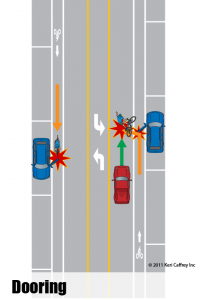 The Door Prize: Driver or passenger opens the door of a parked car into the cyclist. This can be a deadly collision. Typically, the handle-bar hits the door, turning the front wheel to the right and sending the cyclist flying to the left – where the cyclist is then run over by overtaking traffic.
The Door Prize: Driver or passenger opens the door of a parked car into the cyclist. This can be a deadly collision. Typically, the handle-bar hits the door, turning the front wheel to the right and sending the cyclist flying to the left – where the cyclist is then run over by overtaking traffic.
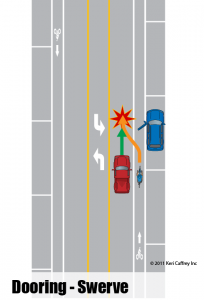 Door Zone Swerve: Cyclist swerves to avoid a suddenly-opened door and is hit by an overtaking car. This crash type accounts for many fatal crashes, but because the cyclist does not hit the door, s/he can end up at fault for the crash.
Door Zone Swerve: Cyclist swerves to avoid a suddenly-opened door and is hit by an overtaking car. This crash type accounts for many fatal crashes, but because the cyclist does not hit the door, s/he can end up at fault for the crash.
Savvy Cycling: Dooring-related crashes are 100% preventable by you! Stay at least 5 feet from parked cars – no matter where the bike lane is. Give room for the door and some additional distance to keep a door from startling you if it is opened near your path. Remember that the width of vehicles, their doors and the distance they are parked from the curb will vary. Account for the widest door and worst parking job and ride in a straight line so you are predictable to other drivers. If staying outside the door zone requires you to control a lane of traffic, do it. While dooring is always the fault of the person opening the door, it is in your interest to avoid being a victim.
 Pothole Plunge: Cyclist crashes because she can’t avoid a surface hazard due to overtaking motorists. This can occur when riding too far right in a narrow lane or when sharing a wide lane or riding in a bike lane.
Pothole Plunge: Cyclist crashes because she can’t avoid a surface hazard due to overtaking motorists. This can occur when riding too far right in a narrow lane or when sharing a wide lane or riding in a bike lane.
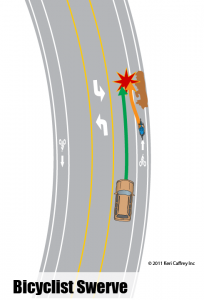 Obstruction Swerve: Cyclist swerves to avoid a surface hazard and crashes or is hit by a car.
Obstruction Swerve: Cyclist swerves to avoid a surface hazard and crashes or is hit by a car.
Savvy Cycling: Ride farther left (are you seeing a theme here?), most hazards are on the right edge of the road. Controlling the lane gives you the whole lane to avoid hazards without having to merge or worry about overtaking motorists. Pay attention to the road ahead so hazards don’t sneak up on you. Learn to avoid a surface hazard without swerving (taught in CyclingSavvy). Never move left without looking behind you. Also keep in mind that when riding in a bike lane, your speed should be such that you have time to see and avoid the kind of debris hazards that are naturally swept there. Don’t ride in a bike lane at downhill speeds.
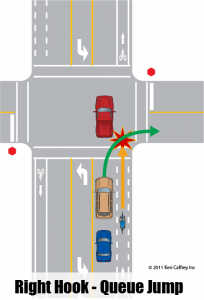 Passing-on-the-Right-hook: Cyclist passes slow-moving cars on the right and car turns right into cyclist. This is a common bike lane crash.
Passing-on-the-Right-hook: Cyclist passes slow-moving cars on the right and car turns right into cyclist. This is a common bike lane crash.
Savvy Cycling: Don’t pass slower/stopped traffic on the right. Use extreme caution if you need to pass a queue of traffic. You can’t rely on motorists to use their turn signals or to look before turning or merging into a bike lane. Merge left into the traffic lane if you are moving the same speed as traffic. Merge left into the traffic lane before intersections, you can then easily pass right-turning cars on the left.
Right-hook from Stop-light: Cyclist is stopped to the right of traffic, light turns green, cyclist goes straight and first motorist turns right into her. This crash often results from cyclists misunderstanding the limitations of bike lanes. Usually the cyclist arrives after the motorist and is not seen. It can be deadly.
Savvy Cycling: This is completely avoidable. Don’t pull up next to stopped traffic. Bike lane stripes are dashed before intersections for a reason: to encourage right-turning motorists to merge right and straight-thru cyclists to merge left (unfortunately, most motorists and cyclists don’t know this). Merge into the line of traffic and cross the intersection in the traffic lane. (See also What Cyclists Need to Know About Trucks)
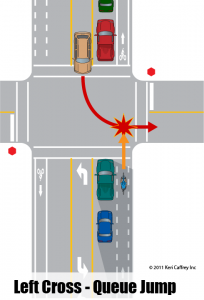 Blind Left-cross: Cyclist is passing stopped traffic and is hit by motorist turning through a gap. Bike lanes often contribute to this kind of crash.
Blind Left-cross: Cyclist is passing stopped traffic and is hit by motorist turning through a gap. Bike lanes often contribute to this kind of crash.
Savvy Cycling: Be aware that moving or stopped cars to the left of you obscure your visibility to traffic in the oncoming lane. Ride in the line of traffic if it is moving close to your speed. Merge to the left into the traffic lane before intersections. When following a large vehicle through an intersection, move far left so left-turning motorists see you. If you choose to pass a queue of stopped traffic on the right (with or without a bike lane), drive slowly and carefully, stop at gaps in the traffic to your left and expect crossing conflicts.
Crosswalk/Sidewalk Slam: Car turns into cyclist riding in crosswalk or across a driveway on the sidewalk. All of the crossing crashes (right hook, left cross, drive-out) discussed in this section happen to cyclists riding on the sidewalk. The sidewalk cyclist is even more vulnerable than the roadway cyclist because she is less relevant and sometimes invisible.
Savvy Cycling: Don’t ride on the sidewalk. Avoid sidepaths in areas with lots of intersections and driveways. If you do choose to use a sidepath, use caution when approaching any place cars can cross it. Be aware motorists are focused on the travel lanes and typically “tune out” activity on the margins. Sidewalks are designed for pedestrian speed and the ability to stop instantly at every intersection or driveway. Motorists are not accustomed to look for fast-moving traffic on the sidewalk.
Common Collisions Caused by Illegal Cycling Behavior:
Wrong-way Wallop: Cyclist riding the wrong way gets hit by crossing or turning motorist.
Savvy Cycling: Ride with the flow of traffic. Motorists don’t look for vehicles driving the wrong way.
Scofflaw Smack-down: Cyclist runs a stop sign or red light and gets hit.
Savvy Cycling: Follow the rules. Traffic control devices are for ALL drivers, including bicyclists.
Ninja Knock-out: Any of the common crashes involving a cyclist without lights at night.
Savvy Cycling: You are required by law to have a white headlight and red tail-light and rear reflector on your bike when operating in the dark. Make sure you are visible. Don’t skimp on lights and retro-reflective materials.
Motorists need to pay better attention to their environment – to say the least. They need to look out for pedestrians. And they need to look out for cyclists who don’t know better. But Savvy Cyclists are very much in control of our own safety, even in a less-than-ideal traffic environment.
The Five Layers of Bicycling Safety
By Daniel Gutierrez
Enhanced by Mighk Wilson
Layer 1: Control Your Bicycle (Don’t fall or collide with others)
If you can skillfully control your bike by starting, stopping, and turning properly, you will not fall down all by yourself or run into others. Do this and you cut out about half of your injury risk. To ride in groups, a cyclist must have good bike handling skills.
Layer 2: Follow the Rules (Don’t cause traffic crashes)
Follow traffic laws, obey signs and signals, use headlights and tail-lights at night, and use the correct lanes for turns and through movements, and you won’t cause a collision with a motorist. About half of cyclist/motorist crashes are caused by cyclists who violate the basic rules of the road. But you don’t do that, right? Combine Layers 1 and 2 and you cut about 75% of your injury risk.
Layer 3: Lane Positioning (Discourage other driver’s mistakes)
Knowing when to use the full lane or to share a lane is something few cyclists fully understand. Your position in a lane is the best way to make yourself conspicuous, to tell drivers what you are doing, and to discourage them from making unsafe movements. Many of these effective lane positioning principles have been forgotten by the modern cycling community, so they may be contrary to what you’ve been taught! Combine Layers 1, 2 and 3 and you cut out about 99% of all potential crashes.
Layer 4: Hazard Avoidance (Avoid the other driver’s mistakes)
There are evasive maneuvers you should know that can help you avoid major motorist mistakes or dodge obstacles. Knowing how to stop and turn quickly helps you avoid motorist mistakes that aren’t discouraged by lane positioning. These skills are not instinctive and must be taught.
Layer 5: Passive Safety (Protection when all else fails)
This is actually the least effective layer. Helmets and gloves protect your most vulnerable body parts as a last resort in case of the very rare failure of Layers 1 through 4, but they do nothing to help you avoid crashes.




